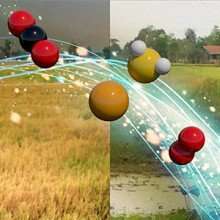A simplified way to predict the function of microbial communities

In areas that flood frequently, microbial communities must adapt to repeated wet-dry cycles. Metabolic strategies help them survive, but these strategies can also influence nutrient cycling and atmospheric emissions from soils and sediments. An international team of scientists examined soils from rice paddies to understand how microbial communities function during floods. Their work suggests analyzing carbon that microbes extracted from water may prove critical to understanding and modeling these important communities.
How microbes function in often-flooded soils has profound impacts on crop production, in part because they can deliver nutrients to plants and stabilize or release atmospheric emissions from soils. Understanding how microbial communities function in soils—before, during, and after flooding—can help scientists better model and promote beneficial changes in those communities.
To understand how microbial activity varied in response to flooding, scientists studied three types of organic matter that are commonly found in three types of rice paddy soils: dried rice straw, charred rice straw, and cattle manure. Team members came from the SLAC National Accelerator Laboratory; Stanford University; Swedish University of Agricultural Sciences; University of California, Riverside; and EMSL, the Environmental Molecular Sciences Laboratory, a U.S. Department of Energy Office of Science user facility. While other studies used a similar approach to look at well-aerated, upland soil and simple carbon compounds, or single micro-organisms, none examined the full complexity of natural soil and carbon substrates during the transition from dry to flooded conditions. The team used EMSL's Fourier-transform ion cyclotron resonance mass spectrometer to analyze dissolved carbon and then observed how microbial functioning changed. These pioneering experiments produced surprising results.
Not only were researchers able to better understand how microbes breathed and obtained energy during flooded conditions, but they discovered that a focus on water-extractable carbon was sufficient to predict microbial respiration rates from diverse metabolic strategies. Though more in-depth studies will be important to reveal underlying functions, the insights gained from this study give scientists a proxy to begin modeling these complex interactions.
More information: Kristin Boye et al. Discerning Microbially Mediated Processes During Redox Transitions in Flooded Soils Using Carbon and Energy Balances, Frontiers in Environmental Science (2018). DOI: 10.3389/fenvs.2018.00015
Provided by Environmental Molecular Sciences Laboratory

















